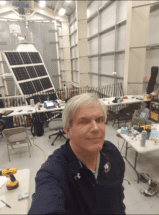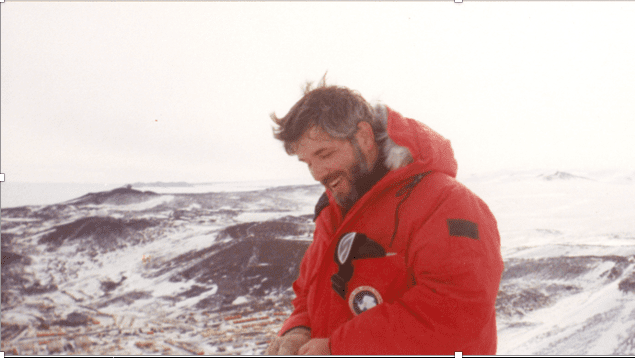Clemson University alumnus Chris Walker, an astronomy professor at the University of Arizona, has been part of what he calls an Antarctic “gold rush.”
But he and others don’t go to Earth’s coldest, driest, highest, and windiest continent to mine its rich mineral deposits. Instead, they are there to mine the ultra-high frequency terahertz photons that rain down from the heavens to gain insight into our cosmic origins.
Walker will be the featured speaker at the 2021 Sobczyk Memorial Lecture at 7:30 p.m. on Oct. 21 in the Freeman Hall auditorium. The lecture will also be available via Zoom at https://clemson.zoom.us/j/92935661693.
Walker is the principal investigator for the GUSTO (Galactic/Extragalactic ULDB Spectroscopic Terahertz Observatory) mission, a $45 million NASA project that will send a high-altitude balloon to near-space, carrying a telescope that will study the interstellar medium — the gas and dust between the stars.
Direct connection
“It sounds like pretty esoteric stuff,” he said, “but 4.7 billion years ago, every atom in your body was the interstellar medium, and a little cloud of this stuff about a light-year across collapsed and formed the sun. Planets are formed as a byproduct of the star formation process, and we’re a byproduct of the planets. So, there’s a direct connection between every atom of your body and the interstellar medium. We need to understand the interstellar medium to understand how stars and planets and people form.”

The mission, delayed until Dec. 2022 because of the pandemic, will map out large sections of the plane of our Milky Way and a nearby galaxy known as the Large Magellanic Cloud.
Walker earned his B.S. in electrical and computer engineering at Clemson in 1980. A summer internship at the National Radio Astronomy Observatory in Tucson, Arizona, before his senior year helped shaped his career. During the internship, he worked on instruments for a 36-foot telescope at Kitt Peak National Observatory. “The astronomy bug bit me pretty hard,” he said. After returning to Clemson, he took an introductory astronomy course. Some years later, he would use that same Arizona facility for his dissertation, in which he provided the first observational evidence for a collapsing protostar.
Walker earned his master’s degree in electrical engineering at Ohio State University, where he served as chief engineer of the university’s radio observatory.
After working at TRW Aerospace and the NASA Jet Propulsion Laboratory, Walker pursued a Ph.D. at the University of Arizona. Following a Millikan postdoctoral fellowship in experimental physics at the California Institute of Technology, Walker returned to Arizona, where he is a professor of astronomy at Arizona’s Steward Observatory with joint appointments in the university’s departments of Optical Sciences, Electrical Engineering, Applied Mathematics, and Aerospace Engineering. Besides terahertz astronomy, Walker’s research also focuses on the development of astronomical instrumentation. He wrote “TeraHertz Astronomy,” the first textbook in his field.
‘Gold rush’
Walker provided an abstract for his upcoming lecture:
“Over the past 25 years, there has been an Antarctic ‘gold rush,’ not to mine the rich mineral deposits that exist there, but to mine the ultra-high frequency terahertz photons that rain down from the heavens.
The terahertz (THz) portion of the electromagnetic spectrum ( ~ 1 to 10 THz;) provides a powerful window into cosmic evolution. THz photons arriving at Earth can yield valuable insights into everything from the birth and death of stars to the cataclysmic events associated with the origin of galaxies and the universe itself.
Milky Way
Most of the THz photons we observe are emitted by the gas and dust between the stars, that is, the interstellar medium. At THz frequencies, we can observe photons associated with the interstellar medium of our galaxy, the Milky Way, as well as from the interstellar mediums of distant galaxies.
The evolution of THz astronomy has been driven largely by two factors — the atmospheric absorption of THz light and the availability of detector technology.
Water vapor in the Earth’s atmosphere is a very efficient absorber of THz photons. Therefore, THz observations are best conducted from space-based telescopes, balloon-borne telescopes, airborne observatories or telescopes at high, dry, cold sites on Earth. In this presentation, we will discuss what it is like to be a terahertz astronomer in Antarctica and what insights into our cosmic origins this branch of astronomy provides.”
The annual lecture series is named after the late Andrew Sobczyk, a well-known professor and researcher in mathematics and mathematical physics. A public endowment established by Sobczyk’s family and friends funds the series. Sobczyk was a professor of mathematics at Clemson from 1965 to 1981.
Get in touch and we will connect you with the author or another expert.
Or email us at news@clemson.edu

